-
Lisa Aschan: She Monkeys (2010)
Lisa Aschan: She Monkeys (2010)French
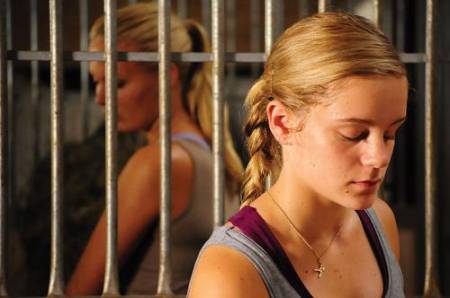
LINDA MOLIN AND MATHILDA PARADEISER IN SHE MONKEYS
Rivalry and friendship between budding girls on a sports team
Swedish first-timer Lisa Aschan's She Monkeys is like Céline Sciamma's 2007 French coming-of-ager Water Lilies (SFIFF 2008), about two girls who bond around a challenging female sport, in Water Lilies water ballet, and here, equestrian gymnastics. There is a popular, or more confident, girl, and the more timid newcomer, though the distinction gets twisted along the way when the strong girl turns out not to be invincible. Here it's introverted Emma (Mathilda Paradeiser) and more experienced equestrian Cassandra (Linda Molin), who become playful friends, and later when Emma turns out to be strong and promising, rivals. This is different from the French film in that the two challenge each other to more real wrongdoing, and Emma has a seven-year-old sister Sara (Isabella Lindquist), whose desire to become a woman and precocious lust for her babysitter cousin Sebastian (Kevin Caicedo Vega) leads her to extravagances of her own. In fact when the energy begins to fade in the Cassandra-Emma relationship, Sara comes in handy by providing comic relief that also pushes boundaries a bit.
In Water Lilies, Marie (Pauline Acquart) isn't on the water ballet team, but thinks she wants to be. She admires Floriane (Adele Haenel), a popular girl on the team who has the boys running around after her. She Monkeys provides some scenes of the equestrian training, but Cassandra and Emma hardly seem interested in boys, who aren't really around much, as they are at Water Lilies' swim center. Floriane is a big flirt, though it's just a pose; another girl, Marie's former friend, is closer to really getting laid. In both of these films, one of the girls turns out to desire the other sexually.
She Monkeys may push boundaries a bit more, but it is less successful at showing its two "girlfriends" in a real social context than the French film is. Nonetheless She Monkeys clearly establishes that Lisa Ashan, whose first feature this is as Water Lilies was Sciamma's, is a talent to watch with a distinctive style.
Apflickorna (the original title) is the fifth and last of a series of low budget first films chosen by competition for the Swedish Film Institute's Rookie Project. It won the Gothenberg, Sweden festival's Nordic film prize and critics' award. Seen and reviewed as part of the San Francisco film festival of 2011, this debuted in the US at Tribeca in 2010.
As Tribeca wrapped it was announced She Monkeys won the Founders Award for Best Narrative Feature. This included $25,000 in award money and the "art award" of a painting by Robert De Niro, Sr. entitled "Anna Christie Entering the Bar, 1965-1967."
SFIFF Screenings
Mon, Apr 25 7:15 / Kabuki
Tue, Apr 26 8:45 / Kabuki
Last edited by Chris Knipp; 05-04-2015 at 10:39 PM.
-
Federico Veiroj : A Useful Life (2010)
Federico Veiroj : A Useful Life (2010
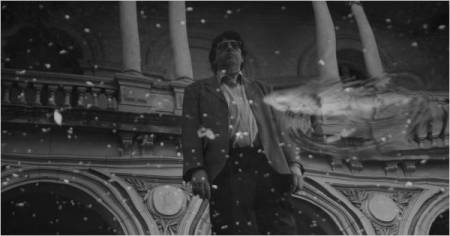
JORGE JELLINEK IN A USEFUL LIFE
Film library abandoned for movie-going -- possible romance?
Federico Veiroj's succinct (67-minute) feature was shot in color and converted to black and white to suggest old movies -- which are the chief concern of Jorge (played by film critic Jorge Jellinek), the protagonist. He is a big, tall, amiably nerdy, pear-shaped man with tinted glasses, out of style like his clothes. He is the manager of the Cinemateca Uruguaya of Montevideo, Uruguay, and he has been doing this for twenty-five years, but it's beginning to look like that may soon come to an end. He and the director confer, trade film series to watch, go over the declining fortunes and physical plant of their operation. The film library may be disintegrating. Ticket sales are not brisk. The projectors are in need of multiple repairs. Even the seats in the auditoriums are giving out. The director's and manager's weekly radio broadcasts are charming, smooth, but rather dry. The director uses a microphone to broadcast live translations in Spanish into the auditorium of the English subtitles for von Stroheim's Greed. For a while this movie looks like it's going amiably nowhere, though its loving contemplation of outmoded technologies -- tapes, faxes, telegrams, pay phones, Russian projectors with special lights no longer replaceable -- has the atmospheric charm of a world where people are excited about Italian films of the Sixties; The Cabinet of Dr. Caligari; or the way Prokofiev's music shapes the battle sequence of Alexander Nevsky and the structure of Citizen Kane becomes clear only after multiple viewings. Then outside the Cinemateca Jorge meets an old friend called Paola (Paola Venditto), who has come for a screening. He gives her a comp ticket. He waits patiently for her to come out and invites her for coffee. No, she says, she has too many exams to grade. But she shows interest. Suddenly a little flower opens up.
And a big flower closes. The corporation that has been supporting the Cinemateca announces to Jorge and his boss, the director (Manuel Martínez Carril, actual former Cinemateca director) that it can unfortunately no longer support organizations that do not show any profit. Meanwhile the landlord threatens eviction within a few days because the rent has not been paid for eight months.
A Useful Life turns gradually around after the Cinemateca is closed. Jorge does a little dance, literally and figuratively. He gets an expensive haircut, one so elegant you can hardly tell his hair has been cut at all, though it's been beautifully washed and combed. He skips up and down some big marble steps, as if remembering a Fred Astaire routine. Then he goes to the university, where he enters a classroom along with the students and gives an impromptu and surprisingly fluent little lecture on the nature and necessity of lying -- till the real professor comes in and he departs. Finally he waits outside the university buildings until he finds Paola coming out of her class, and asks her: Would you like to go to the movies? "The movies?" Paola asks, pausing. Why yes, she would. And with old movie music playing in a montage of classic finales, Paola and Jorge go off into the magical darkness of the streets of downtown Montevideo as evening falls. It is a beautiful and hopeful ending.
Veiroj is working with things he knows and people he knows. The actors are not far from their real selves, and unlike some cases of that, they fit into themselves comfortably. Veiroj himself worked at the Cinemateca. (It has not, in reality, been forced to close.) But above all the film captures a slow pace and gentle end-of-the-world melancholy that perhaps only Uruguay, or the Patagonia of Carlos Sorin, can evoke. Special kudos to the director for his skill in using non-actors, in particular the way he makes Jorge Jellinek come alive and seem, after all, an attractive man. The fancy hairdresser brings that out: middle-aged though he may be, Jorge has beautiful thick head of glossy black hair. His radio talks and impromptu university lecture show his silver tongue. And his towering height, as the dance up and down the stairs shows, is both impressive and nimble.
Una vida útil is a simple but accomplished film, a short-short story rather than a novel. It develops its milueu and its characters with a sure touch. You might want to contrast this with Davide Ferrario's more commercial and elaborate After Midnight/Dopo mezzonotte (2004), starring Giorgio Pasotti, a film in which the magical Mole Antonelliana (the cavernous Museum of Cinema in Turin, Italy) is the setting for a very unlikely love story. Not as economical by a long sight (the plot gets a bit complicated at the end), but the setting is remarkable.
Shown as part of the San Francisco International Film Festival of April-May 2011. The film opened in Uruguay in August 2010, in Canada and Spain in September. It had a brief run in New York in January 2011 and was a New York Times Critic's Pick when reviewed by Jeannette Catsoulis. Global Film Initiative is the distributor.
SFIFF Screenings
Sun, Apr 24 12:00 / New People
Mon, Apr 25 7:00 / PFA
Sat, Apr 30 3:45 / Kabuki
Last edited by Chris Knipp; 05-04-2015 at 10:35 PM.
-
Kwan, Chiang: Let the Wind Carry Me (2010)
Kwan, Chiang: Let the Wind Carry Me (2010)
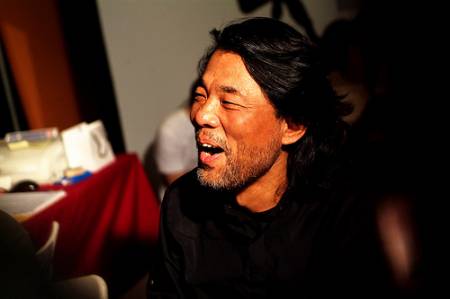
MARK LEE PING BING by dalobeee
A great cinematographer from Taiwan
Kwan Pun-leung and Chiang Hsiu-chiung have made a documentary that celebrates one of the most significant cinematographers today, Mark Lee Ping Bing, who has worked extensively with Hou Hsiao-hsien, Wong Kar-wai, and other great Asian directors like Tran Anh Hung and Hirakazu Koreeda, as well as some European ones. Mark Lee's passion for light and color emerges as rapidly as does his striking appearance. He's a gnarly, beaded, handsome, macho guy but wait... there's something not right, because he's such a workaholic he completely neglects his wife and kids, and only occasionally has done justice to his beautiful, smiling, youthful mother, now 80, who raised him after his father died young. Mark Lee is admired and beloved, but he is a solitary wanderer, perpetually on the road, who when he received notice that he had won his native Taiwan's highest cultural honor, was terrified that the 20 phone messages meant something dire had happened to his family, and kept the great news of his honor when he opened the messages to himself. What kind of man is this? Well, an artist, certainly, maybe a great one, who is as subtle and dedicated as he is open and willing to share his secrets with newcomers to the craft he represents so impressively -- but whose dedication takes its toll on his personal life. We never see Lee's California-based wife at all, and we see his son Jason telling how when as a boy he saw his dad getting an award on TV, he went and turned the set off, because he was angry to be reminded his father was always away. "Now that I'm older I understand better," he says. But this kind of father takes a lifetime to come to terms with. At another time fires endangered his family in California, but Lee knew little about it.
Lee is in almost every frame of this film, describing his formation and his passions, and we see images from Hou's A Time to Live and a Time to Die, Goodbye South, Goodbye and Three Times as well as Flowers of Shanghai. Hou's and Lee's battle over the lighting of the latter was a turning point, Lee says. Lee fought to have an enhanced version of candlelight, while Hou wanted scenes simply to be shrouded in darkness. Lee's concern is always to celebrate light in a natural way, but light, not darkness. His sense of nature has a Taoist quality. He goes with the flow (one subtitle actually has him say that) and if it rains when they meant to shoot in sunlight, they must change the scene to rain. If it snows in the desert, they must capture that -- the story behind a striking sequence in Jiang Wen's "The Sun Also Rises,. The movement of leaves in the wind can have a special grace (in Tran Anh Hung's atmospheric and beautiful The Vertical Ray of the Sun). Nature always comes through, Lee says.
Somehow things became easier in the ongoing combative relationship between Hou and Lee after Flowers of Shanghai, and they went on to make Millennium Mambo and Flight of the Red Balloon together. There are sequences showing the shooting of Red Balloon in Paris, and a lot of the interview footage was shot there (allowing several French contributors to come in, including Romain Duris, Grégoire Colin, and a French director, scenes of Lee partying with film crews and reminiscing about his early days, and Lee's endless rambling, which entertains, but blurs a sense of the chronology of his career.
Director Silvia Chang describes Lee's apprenticeship years in Taiwan as teaching him to be fast and accurate. Wong Kar-wai speaks only briefly, though with great admiration. The word "stability" occurs more than once. It's quality the Chinese crews look for and that Lee supplies. He's solid, reliable, quietly passionate. Wong suggests that if Christopher Doyle, his most famous cinematographer collaborator, is a sailor, Lee is a soldier. There's some focus on In the Mood for Love, particularly the final sequence. Wong says when Lee is given wide open spaces to shoot, he is in his element.
This is a documentary drenched in cinematic charisma, but not a technical treatise. The nature of Lee's style as a cinematographer is only suggested by comments and clips. His talk of color and light is fascinating, and we can appreciate what he means when he says he learned emotion from Hou. Unfortunately though there are clips of some of the most known of the 50-odd films Lee has worked on, Variety reviewer Russell Edwards notes that many are not sampled at all, and "the poor quality of some of the clips betrays poor Asian archiving standards and suggests limited access to original prints..." The film arouses mixed emotions. It evokes awe at the Asian cinematic greatness of the Eighties and Nineties to which Lee significantly contributed, but there is doubt about where things are going now, and this seems only a fragment of a larger survey. Edwards concludes: "Lee may have been responsible for some of Asia's best-looking cinema of the past 20 years, but the presentation proves Quentin Tarantino's adage that "the projectionist gets final cut."
Seen and reviewed as part of the San Francisco International Film Festival, April-May 2011.
SFIFF Screenings
Fri, Apr 29 6:15 / New People
Sun, May 1 1:30 / Kabuki
Wed, May 4 3:45 / Kabuki
Last edited by Chris Knipp; 05-04-2015 at 10:32 PM.
-
Pang Ho-cheung: Love in a Puff (2010)
Pang Ho-cheung: Love in a Puff (2010)

Miriam Yeung Chin Wah and Shawn Yue in Love in a Puff
Smoking restrictions lead to urban romance
The girl has mauve hair, an indication of the hipness of this couple who first meet on a smoke break in a Hong Kong alleyway. He's in advertising; she sells cosmetics. And his shirt is the same color, signaling an affinity this movie seeks to explore. A Hong Kong ordinance prohibited smoking in all indoor areas. Employees began gathering in cliques they called "hot pot packs" to smoke outdoors, talk, and have fun. That's the starting point. There's much camaraderie and banter -- liberally laced with profanity -- among the "hot pot pack" that includes a man with round glasses, a girl with a knit cap, a Pakistani pizza man, a little uniformed hotel bellman -- and the couple-to-be, Jimmy (Shawn Yue) and Cherie (Miriam Yeung Chin Wah). The movie begins with a dramatization of a shaggy dog story about a man locked in car trunk in a parking lot who turns out to be a ghost. There's a lot of joking round, and things stay very light, becoming just a little romantic when Jimmy joins Cherie at a costume birthday party at a Karaoke bar -- except Cherie turns out to have a boyfriend, KK (Jo Kuk).
Eventually he finds out about Jimmy (and we see how much fun he and Cherie are having together) and he gets jealous. Love in a Puff shows how romantic text messaging can be -- and how it can give away secrets if spied on. And when Cherie decides to switch to Jimmy's network so her SMS fees aren't too high, Jimmy's cohorts at work say she's too aggressive. Jimmy has just had a breakup with a girlfriend at work, and Cherie is older. These are the givens that do nothing but fuel the mutual attraction.
This movie excels in its constant interplay of lightness and seriousness, in the way the milieu and the social world is sketched in, and in the great chemistry between Yeung and Yue. Their dialogue is breezy and sometimes touching. Dialogue in group scenes is feisty and provocative by sometimes strict Hong Kong standards; Love in a Puff caused some controversy, which could add to its hip gloss for locals. Some of the whimsy recalls romantic moments in Wong Kar-wai; it's all more mundane, but enough to show that Wong's tropes are far from unique and sometimes come from Hong Kong pop culture.
If only Pang had taken more breaks from the sit-com charm and stepped back a little, he might have created a bit more magic. There is a hint of that in a silhouette-and-full-moon sequence of Cherie at the 80-minute mark, when the story reaches its make-or-break get-serious point. At film's end, the couple come to some kind of commitment, with Jimmy's Land Rover stalled on an overpass, appropriately enough by making serious plans to both give up smoking, and focus on each other.
The apparent triviality of the subject matter, along with the modern urban couple's difficulty with communication (despite multiple platforms) is offset by wit and keen observation of little details every step of the way. This light, cinematic, amusing movie is appealing and fresh -- and has an assured polish, along with casual touches, like the little small-screen 16mm interviews that serve as occasional commentary. All in all, Love in a Puff is a delightful little piece of fluff, as casual as its lovers try to be. An online critic, listing this as one of his top movies of 2010, characterized it as "forgettable in an unforgettable way," and that's about right. Not all will like this; Asian film critic Derek Elley called it "peculiarly pointless" and "progressively boring." Local commentaries say the film won't work dubbed in Mandarin because its Cantonese profanities are untranslatable and had the audiences in stitches throughout. Subtleties apart, the English titles give a fair sense of this pungency. Some little SMS tricks emerge too: for instance, if you type "i n 55!W !" it looks like nonsense or code, but turn the phone upside down and it reads "I MISS U!" Of such details are Puff's flavor and charm made.
After its initially rocky debut in Hong Kong due to its profanity and heavy nicotine use, Love in a Puff has breezed along the festival route, appearing in Seattle, Melbourne, Tokyo, Palm Springs, landing in April 2011 at the San Francisco International Film Festival, where it was screened for this review. The original Chinese title is Chi ming yu chun giu/志明與春嬌 which means simply Jimmy and Cherie. I was not previously familiar with the work of this prolific 2000's Hong Kong director.
Love in a PUff, 101 mins., opened in Hong Kong 24 March 2010.It was screened for this review as part of the 2011 San Francisco International Film Festival, where it showed 28 and 30 April 2011.
Last edited by Chris Knipp; 05-05-2015 at 11:54 AM.
-
Park Jung-bum: The Journals of Musan (2010)
Park Jung-bum: The Journals of Musan (2010)
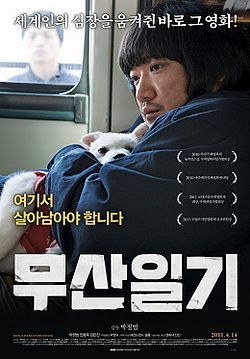
PARK JUNG-BUM IN THE JOURNALS OF MUSAN
Study of an outcast
Park Jung-bum served as assistant director on Lee Chang-dong's outstanding recent film, Poetry (NYFF 2010). In this strong directorial debut he focuses on the plight of a North Korean refugee from Musan in the South Hamgyeong Province struggling to scrape together an existence in South Korea. Jeong Seung-chul (Park Jung-bum himself), who has just emerged from eight months in a resettlement camp, lives at the edge of a demolition pit in the sprawling outskirts of Seoul. The 125 prefix on his ID card number tells potential employers he's a defector from up there, and hence undesirable. All Seung-chu can find to do is put up sex show posters for a sleazy promoter, a job that takes him to dangerous neighborhoods where he risks beatings. In contrast to Seung-chu is his roommate Kyung-chul (Jin Yong-uk)), who embraces the capitalist life with ease, getting high commissions on money deals and dressing in the latest Nikes. Meanwhile Seung-chu plods around in the grim gray Seoul winter with his bowl-cut hair and his hunched-over posture. The result is a powerful film but one so relentlessly downbeat (and over-long) that it sometimes undercuts its own purpose -- to delineate a personality and a social situation. But one won't soon forget this protagonist.
It is impossible for those of us who don't know Park and haven't seen him in person to know how much of his impersonation of Seung-chul is performance and how much is his natural given physicality. He has said he had to take the role because only he knew perfectly the mannerisms of the defector friend he based it on. Shots of his rounded, large back are very expressive in themselves. It could be the upper torso of a body-builder gone slack. The meekness is not without a hint of danger, as with Lennie in Of Mice and Men. In the film, Seung-chu wanders hopelessly, meeting up periodically with Kyung-chul, who tries to help him but also feels contempt for him. Perhaps his only friend is the little white mongrel dog he adopts, whose fate is as uncertain as his. The place where they live itself is symbolic of deprivation. As Jay Weissberg of Variety describes it, it's "on the hilly outskirts of Seoul next to a no-man's-land of semi-wrecked buildings toppled to make way for cookie-cutter housing projects." It's a vast, desolate and steep wasteland, not unlike the scene of some Italian neorealist films, which may be a point of reference for Park, as well as the Dardenne brothers. Even here Seung-chu finds a little Christian church and takes unsteady refuge there. He feels like an outsider, and meets no one, but is attracted by a pretty choir member, Sook-young (Kang Eun-jin).
He finds that Sook-young works at a Karaoke bar, and takes a job there himself, which only leads to her discomfort, because she is embarrassed as a devout Christian to be working in such a place. This work leads to his humiliation and yet another beating, this time by drunken customers outraged when he shows moral disapproval of their revelry. Perhaps Seung-chu is a fool of God. On the fringes of modern capitalism, even a saint appears like a cretin and a fool. Is Seung-chu's behavior a sign of moral fervor or simply of an inability to thrive, as the venial, brash Kyung-chul does, in this cutthroat environment? Seung-chu loses both the poster job and the karaoke job; but Kyung-chul gets in bigger trouble: he has lost $25,000 of other people's money.
Eventually more truths emerge about Seung-chu's inner rage and his reason for defecting from North Korea. The narrative is well-paced. As Weissberg says, Park has done a great directing job and created a remarkably memorable, even archetypal, protagonist; yet at 127 minutes the film is loaded with fat crying out to be trimmed off, including a good 10 minutes past where the story really ends. Still, this is a memorable piece of work, distinguished by raw acting and cinematography that is always detached, but sometimes surprisingly light and beautifully pastel in color. There is only ambient sound and music.
The Journals of Musan has been presented and been well received at various festivals, including Pusan (where it debuted in October 2010), Marrakech (where it won the top prize), Berlin, Rotterdam, Hong Kong, Tribeca -- and at the San Francisco International Film Festival of April 2011, where it was screened for this review. At Tribeca Park Jung-bum was awarded the Best New Narrative Director prize, along with a total of $75,000 in award money.
SFIFF Screenings
Fri, Apr 29 9:15 / Kabuki
Sun, May 1 8:30 / New People
Mon, May 2 1:00 / Kabuki
Last edited by Chris Knipp; 05-04-2015 at 11:02 PM.
-
Lech Majewski: The Mill and the Cross (2011)
Preview
Lech Majewski: The Mill and the Cross (2011)
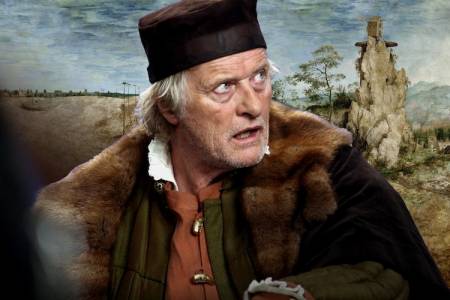
RUTGER HAUER AS PIETER BRUEGEL THE ELDER IN THE MILL AND THE CROSS
A sixteenth-century Flemish painting and its world brought to life on screen
Rutger Hauer, Michael York, and Charlotte Rampling are among the luminaries involved in the making of this strikingly beautiful as well as emotionally shattering art film recreating the making of a great painting. It's Pieter Bruegel the Elder's 1564 "The Procession to Calvary" (also known as "The Way to Calvary"), a panoramic vision showing both the Crucifixion of Christ and the brutalization of Bruegel's Flemish homeland by its contemporary Spanish occupiers. The Polish director Majewski uses state of the art techniques, including high-definition digital visuals, to bring the viewer, and his large cast in period costume, into the painting. The effect, says leading Variety film critic Dennis Harvey, may be enough (if the film is seen by the right audiences) to carry the director into the kind of international prominence enjoyed by Alexei Sokurov with his celebrated museum tour deforce, Russian Ark. Like Sokurov's single-take wonder, The Mill and the Cross isn't exactly a documentry, or an art piece, or a feature film; it's sui generis. On the other hand, some who saw this film at its Rotterdam screening felt that it "cried out for the 3D treatment" and without that "falls flat." This is the view of Hollywood Reporter's Neil young, who does, however, give the film, a Polish/Swedish co-production spoken (perhaps unfortunately) in English, credit for providing viewers with the full historical context of the painting.
Some of us are not passionate fans of the master Sokurov's museum tour de force to begin with, and there may be something initially distracting about the use of English and Michael York's initial voiceovers, which bring to mind his parodic turn in Austin Powers. But it's highyl debatable whether any screen situation ever cried out for the 3D treatment. Ultimately what happens here is just fine. The imaginative transfer of an artist's life on film has some of the luminosity of Peter Webber's Vermeer story, Girl With Pearl Earring, and some of the life and imagination of Derek Jarman's Caravaggio. (These are staged in English too, and the succeed because of their visual imagination.) However while it recreates the cruelty of the Spanish militia, who punish a supposed heretic by beating him mercilessly, strapping him to a wheel, and hoisting him high on a pole to have his eyes pecked out by crows, and dramatizes Bruegel's own household with a dozen wicked children dancing about in bedclothes, this film's primary and compelling focus in on the creation of this single painting.
Majewski has already established the menace of the Spanish militiamen with the horrific torture to death of the protestant. Now the danger they represent feels doubly real as the martyrdom of Christ is staged. Shooting in four different countries, Majewski builds up his scene with awesome verisimilitude and a brilliantly original sense of the particular detail. A triumph.
This film was shown at Rotterdam, and debuted at Sundance in January 2011, where it was well received. Seen and reviewed here in connection with the San Francisco International Film Festival, April 22-May 4, 2011.
SFIFF Screenings
Sat, Apr 23 12:30 / SFMOMA
Wed, Apr 27 9:00 / Kabuki
Last edited by Chris Knipp; 05-04-2015 at 10:13 PM.
-
Dan Geller, Dayna Goldfine: Something Ventured (2011)
Dan Geller, Dayna Goldfine: Something Ventured (2011)
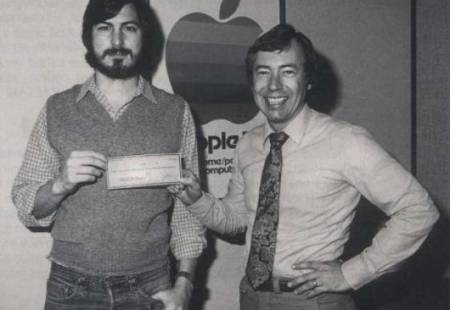
JOBS AND MARKKULA: THE FIRST CHECK.
The beginnings of venture capital and historic West Coast startups
Venture capital and its key role in tech startups over the past four decades are the topics of this little documentary. It describes the first venture capitalists, who funded funny little companies like Apple, Intel, Google, Genentech, Cisco, Tandem and Atari. This is the seventh film from the documentary team of Dayna Goldfine and Dan Geller (previous efforts have concerned Sundance, Isadora Duncan, and the Ballets Russes).
This begins with Arthur Rock, a Wall Street banker, in 1957, who funded "the Traitorous Eight," a group of engineers in California who broke away from William Shockley, the Nobel winning semiconductor guy, who was hard to work for. Rock seems to have invented the idea of venture capital, and the idea of a breakaway group of smart young guys starting their own company, both new ideas at the time. His bank's Wall Street wealthy weren't interested in investing in California, and a lot of big companies turned Rock down. But a a wealthy entrepreneur called Fairchild came up with the $1.5 million Rock was looking for, and Fairchild Semiconductor was born, in Mountain View. It was the beginning of Silicon Valley.
Maybe the next really significant story, after a lot of venture capital and startups and the growth of Silican Valley, is Kleiner Perkins in the late Seventies achieving success with Tandem Computers. (KPCB, Kleiner, Perkins, Caufield and Byers, begun by Eugene Kleiner, Tom Perkins, Frank J. Caufield, and Brook Byers in 1972, is the world's largest venture capital firm.) Tandem Computers broke away from the dominance of IBM and developed foolproof computers that are still used by Wall Street, airlines, credit card companies -- settings where computer breakdown and loss of data are not acceptable outcomes. Tandem became a Fortune 500 company. Kleiner Perkins began with an investment of $1.4 million in 1974, and sold Tandem to Compaq for $3 billion in 1997.
Next comes Atari and the eccentric Nolan Bushnell and "home Pong," the first compact non-coin operated computer game, which finally got going through Sears in 1975 after a hard time finding investors. Computer games now account for a third of all consumer entertainment spending in the US. Next big story: venture capitalist/promoter Bob Swansan and scientist Herbert Boyer and Genenech, the beginnings of genetic engineering, soon to be used to produce drugs on a vast scale and save hundreds of thousands of lives. And of course make tons of money. This is another thing of Kleiner Perkins, and the debonair, elegant Tom Perkins is one of the main narrators of the film's story. Genentech began with an investment of $250,000 (they kept it low by subcontracting the labs) in 1976, and ended for Kleiner Perkins when they sold Genentech to Roche for $47 billion in 2009.
These stories are all great and there's just one after another. Next, again 1976, the two Steves, Wozniak and Jobs, a scruffy, arrogant pair who tended to turn off investors, find Mike Markkula, retired at 32 from Intel, who comes out of retirement to find a tiny investment to get Apple started with a home computer. Arthur Rock, our starting point venture capitalist, is called in. Initial investments: Mike Markkula, $142,000, Arthur Rock, $57,000, and Don Valentine, $150,000. The 2010 market value of Apple? $220 billion. Nice return, eh?
Okay, but venture capital investments often fail, or bring only mediocre return, or just sit there and eat up investors' time and energy. Thus Power Point presentation software lost its backers, one guy took it on, and he and a few others sold it later to Microsoft. Their big mistake? The could have taken the buyout in Microsoft stock, but took cash, losing an untold amount of wealth they'd have gained if they'd taken shares in Bill Gates' company. Oh well.
Cisco Systems is an Internet story and a restructuring drama. The company run by a couple at home ran routers, which in 1984 didn't yet mean anything. Cisco is an example of the necessity of firing heads of companies for them to move forward. The founding couple were hard to deal with, and for the structure, the many vice presidents, to continue, they had to go, and they did. They went away, in their mid-thirties, with $170 million, but they have never forgiven the venture capitalists who okayed their removal. Sandy Lerner (the Cisco wife) went on to create a lot of other companies through investment. Cisco began with an investment by Sequoia of $2.8 million in 1987. It's 2010 value was $150 billion.
The stories are simple. And the conclusion is simple. Venture capital is nothing without entrepreneurship. But new things don't get started as well, or maybe not at all, without men with money willing to take chances on new ideas. Since 1960 the filmmakers figure venture capital has invested over $450 billion and started over 27,000 companies. As Atari founder Nolan Bushnell puts it, without venture capitalists, "the future wouldn't get started nearly as quickly." That's the useful message of this succinct 85 min. film. Something Ventured doesn't go into deep analysis of its stories. What about other personal computer ideas besides Apple, for instance? What about other venture capitalists besides its leading figures? But the film provides a straightforward survey of some of the major tech company startups and the role played by money in getting them going.
Seen and reviewed as part of the San Francisco International Film Festival, April-May 2011. A Zeitgeist Films release. This film debuted at the SXSW festival in Austin, Texas. (Film website here.)
SFIFF Screenings
Sun, Apr 24 2:00 / PFA
Sun, May 1 3:00 / Kabuki
Last edited by Chris Knipp; 08-26-2016 at 10:23 AM.
 Posting Permissions
Posting Permissions
- You may not post new threads
- You may not post replies
- You may not post attachments
- You may not edit your posts
-
Forum Rules





 Reply With Quote
Reply With Quote






Bookmarks